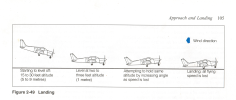Have you looked at the Jacobson Flare? I ran across it in the mid 2000s. At that time Mr. Jacobson had it available as a PDF download of about 16 or so pages that explained the theory, the math, and the practical applications. I learned it and applied the principles to my Cherokee and it helped me.
After I sold my Cherokee and bought my Mooney in 2019, I had lost my first copy and looked for it again to refresh my understanding. What I found was nothing like the original pamphlet and it was right expensive. I think Mr. Jacobson had passed and his family wanted more money for his idea. I would have been happy if I could have purchased the original pamphlet for a reasonable fee, but that was not an option.
I just checked and they now have a pdf version that is free. It doesn't have any math and I have not had time to read but it all might be worth a look. The general principle is that if you are on the glide path at the proper glide angle, then the horizontal distance from the aim point is proportional to the vertical distance above the ground, and using that that distance as a guide helps you begin the flare in a more precise manner. The math helps you tune your sight picture to any aircraft from a small trainer to a 747.
The Jacobson Flare helped me become more consistent with my landings at a time when I needed it. Maybe it will help you in you quest to be a better instructor. Hope this helps.
After I sold my Cherokee and bought my Mooney in 2019, I had lost my first copy and looked for it again to refresh my understanding. What I found was nothing like the original pamphlet and it was right expensive. I think Mr. Jacobson had passed and his family wanted more money for his idea. I would have been happy if I could have purchased the original pamphlet for a reasonable fee, but that was not an option.
I just checked and they now have a pdf version that is free. It doesn't have any math and I have not had time to read but it all might be worth a look. The general principle is that if you are on the glide path at the proper glide angle, then the horizontal distance from the aim point is proportional to the vertical distance above the ground, and using that that distance as a guide helps you begin the flare in a more precise manner. The math helps you tune your sight picture to any aircraft from a small trainer to a 747.
The Jacobson Flare helped me become more consistent with my landings at a time when I needed it. Maybe it will help you in you quest to be a better instructor. Hope this helps.
Last edited:





